Career
In Germany
Karl-Heinrich Riewe was born in Frankfurt, Hesse, Germany, on June 26, 1907, into a German Jewish family.: 103–104 [1] In spite of being born into a Jewish faith, he was a devoted Protestant Christian, as stated in his university job application submitted for the teaching position at the Wesleyan University in Connecticut, United States in 1937.: 104 [1] In 1928, he entered in the Technische Hochschule in Charlottenburg (now Technische Universität Berlin) to study mechanical engineering but eventually received his doctorate in physics from the Humboldt University of Berlin in 1936–37.: 363 [2] his thesis contained fundamental research on electrical conductivity at high frequency.: 363 [2]
He struggled to find employment in Germany and submitted an application for a teaching position in the Wesleyan University in the United States.: 121 [1] However, he decided against moving to the United States after accepting a technical position at the Auergesellschaft.: 121 [1]
In June 1941, Riewe co-authored a paper electron optics and plasma physics with the nuclear physicist Fritz Houtermans. [3] At this time, Houtermans was known to have been at the Forschungslaboratoriums für Elektronenphysik (Research Laboratory for Electron Physics), a private laboratory of Manfred von Ardenne, in Berlin-Lichterfelde. The paper cites the two as being at a facility in Berlin; other papers by Riewe, three years earlier (see below), cited him as being at a facility in the community of Berlin-Wilmersdorf, which is in the vicinity of Berlin-Lichterfelde.
In Russia
Near the close of the World War II, the Soviet Union sent special search teams into Germany to locate and acquired the German nuclear scientists or any others who could be of use to the Soviet program of nuclear weapons.: 5–6 The Russian Alsos mission was headed by the Soviet agency, the NKVD, under Avraami Zavenyagin and staffed with numerous scientists, from their only nuclear laboratory, attired in NKVD officer's uniforms.: 5–6 The main search team, headed by Zavenyagin, arrived in Berlin on 3 May, the day after Russia announced the fall of Berlin to their military forces; it included Major General of Engineering Vasily Makhnyov [ ru ], and Russian physicists Yulij Khariton, Isaak Kikoin, and Lev Artsimovich with targets on the top of their list were the physics facilities in Berlin and its environs.: 5–6 [4]
Eventually, Riewe was taken into the Soviet custody and was sent to Russia to work on the Soviet nuclear weapons program at the Laboratory V run by Heinz Pose in Obninsk, either in the initial sweep by the special search teams or later by Pose's six-month recruitment trip, from March to August 1946, with NKVD General Kravchenko and two other officers. [5] [6]
In 1948, Riewe and fellow scientist, Dr. Renger, went on strike for reasons of their work conditions or hoping to be sent back to Germany after their two-year contracts expired. [7] As their actions where while working on a defense project, they were accused of being ring-leaders of sabotage and imprisoned. Riewe received a sentence of 25 years in the Soviet Gulag and disappeared. Soviet detainee, Tamara Andryushchenko, recalled hearing that Riewe had been executed for sabotage. [8]
Postscript
Riewe's widow moved to Sukhumi, where at that time there was workforce of 300 Germans working at Manfred von Ardenne's Laboratory A, in Sinop, a suburb of Sukhumi. [9] [10] She eventually married the German draftsman Willi Lange and gave birth to his daughter in 1950; the family stayed till 1950 when Lange, his wife, Lange's daughter Hannelora, and his wife's children by Riewe, moved to Sungul', where he worked at Nikolaus Riehl's Laboratory V, also known under another cover name, [11] Объект 0211 (Ob'ekt 0211, Object 0211). [12] [13] [14] [15]
After 1953, they were quarantined in the Agudzery (Agudseri) transition camp, after which Germans returned to Germany. [16] [17] Riewe was in the Gulag-managed city of Dzhezkazgan in Kazakhstan.: 131 [1] After the death of Joseph Stalin, his wife and daughter Christiane (born 19/04/1942y.) had railed from Sukhumi returned to Germany.
After some time, Riewe returned to Germany despite the false rumors that he had been executed.: 141 He survived the Soviet labor camp, and was reunited with his family.: 141 The Riewe family settled in western Germany, in Hanau, Hesse, where they lived for the rest of their lives. After returning from Russia, Riewe worked for the German Physical Society in various capacity, and he passed away sometime in August 1970, aged 70, according to the manuscript provided by German Physics Society . [2]

Gustav Ludwig Hertz was a German physicist and a Nobel laureate in Physics for his work on inelastic electron collisions in gases.

Manfred baron von Ardenne was a German researcher, autodidact in applied physics, and an inventor. He took out approximately 600 patents in fields including electron microscopy, medical technology, nuclear technology, plasma physics, and radio and television technology. From 1928 to 1945, he directed his self-funded and private research laboratory Forschungslaboratorium für Elektronenphysik, where he developed and invented many techniques used in modern physics.

Nikolay Vladimirovich Timofeev-Ressovsky was a Soviet biologist who, in principle, was a senior scientist in Soviet programs of nuclear and, later in biological weapons. He conducted research in radiation genetics, experimental population genetics, and microevolution. His life was highlighted by scientific achievements in the face of severe personal hardship, including his imprisonment and working in secret scientific facilities of Soviet Gulag.
Karl Günter Zimmer was a German nuclear chemist who is best known for his work in understanding the ionizing radiation on Deoxyribonucleic acid (DNA) and did fundamental work on radiation biology.
Nikolaus Vasilyevich Riehl was a German nuclear chemist of Russian-Jewish descent. Before the fall of Berlin, he was director of the scientific headquarters of the Auergesellschaft AG, and was taken to the Soviet Union.
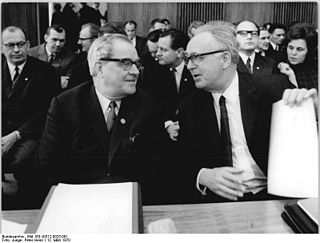
Max Christian Theodor Steenbeck was a German nuclear physicist who invented the betatron in 1934 during his employment at the Siemens AG.
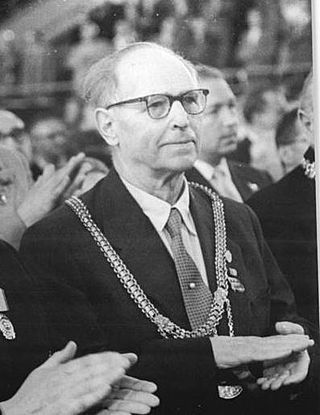
Max Volmer was a German physical chemist, who made important contributions in electrochemistry, in particular on electrode kinetics. He derived and co-developed the Butler–Volmer equation, and was a professor of chemistry at the Technical University of Berlin.
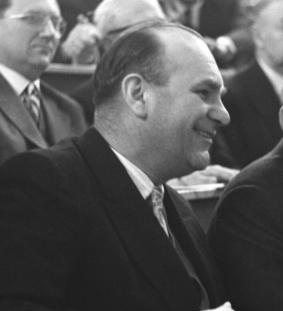
Heinz Barwich was a German nuclear physicist. He was deputy director of the Siemens Research Laboratory II in Berlin. At the close of World War II, he followed the decision of Gustav Hertz, to go to the Soviet Union for ten years to work on the Soviet atomic bomb project, for which he received the Stalin Prize. He was director of the Zentralinstitut für Kernforschung at Rossendorf near Dresden. For a few years he was director of the Joint Institute for Nuclear Research in Dubna, Soviet Union. In 1964 he defected to the West.

The Soviet Alsos or Russian Alsos is the western codename for an operation that took place during 1945–1946 in Germany, Austria, and Czechoslovakia, in order to exploit German atomic related facilities, intellectual materials, material resources, and scientific personnel for the benefit of the Soviet atomic bomb project. The contributions of the German scientists is borne out by the many USSR State Prizes and other awards given in the wake of the second Soviet atomic bomb test, a uranium-based atomic bomb; awards for uranium production and isotope separation were prevalent. Also significant in both the first Soviet atomic bomb test – a plutonium-based atomic bomb which required a uranium reactor for plutonium generation – and the second test, was the Soviet acquisition of a significant amount of uranium immediately before and shortly after the close of World War II. This saved the Soviets at least a year by their own admission.
Heinz Ferdinand Hermann Pose, best known as Heinz Pose, was a German nuclear physicist and a professor of physics at the Technical University Dresden.
Günter Wirths was a German nuclear chemist in the former Soviet program of nuclear weapons and an authority on the uranium metal production, especially on the reactor-grade.

Georg Robert Döpel, best known as Robert Döpel, was a German nuclear physicist and a professor of physics at the Technical University of Ilmenau in Germany.
Alexander Siegfried Catsch was a German biologist and a physician of Russian-descent who was one of the senior German scientists in Soviet program of nuclear weapons, and later his research was used in the Soviet program of biological weapons.
Hans-Joachim Born was a German radiochemist trained and educated at the Kaiser-Wilhelm-Institut für Chemie. Up to the end of World War II, he worked in Nikolaj Vladimirovich Timofeev-Resovskij's Abteilung für Experimentelle Genetik, at the Kaiser-Wilhelm-Institut für Hirnforschung. He was taken prisoner by the Russians at the close of World War II. After rescue from the Krasnoyarsk PoW camp, he initially worked in Nikolaus Riehl's group at Plant No. 12 in Elektrostal’, Russia, but at the end of 1947 was sent to work in Sungul' at a sharashka known under the cover name Ob’ekt 0211. At the Sungul' facility, he again worked in a biological research department under the direction of Timofeev-Resovskij. Upon arrival in East Germany in the mid-1950s, Born became the director of the Institut für Angewandte Isotopenforschung in Buch, Berlin. He also completed his Habilitation at the Technische Hochschule Dresden, where he then also became a professor on the Fakultät für Kerntechnik. In 1957, he received and accepted a call to become a professor of radiochemistry at the Technische Hochschule München in West Germany.
Justus Mühlenpfordt was a German nuclear physicist. He received his doctorate from the Technische Hochschule Carolo-Wilhelmina zu Braunschweig, in 1936. He then worked in Gustav Hertz's laboratory at Siemens. In 1945, he was sent to Institute G, near Sukhumi and under the directorship of Hertz, to work on the Soviet atomic bomb project. Released from Soviet Union, Mühlenpfordt arrived in East Germany in 1955. He was appointed director of the Institut für physikalische Stofftrennung of the Academy of Sciences, in Leipzig. From 1969 until his retirement in 1974, Mühlenpfordt was director of the Forschungsbereiches Kern- und Isotopentechnik der Akademie.

Werner Hartmann was a German physicist who introduced the microelectronics and the semiconductor technology in Eastern Europe.

Laboratory B, also known as Object B or Object 2011 during its period of operation, was a former Soviet nuclear research site constructed in 1946 by Lake Sungul in Chelyabinsk Oblast in Russia. Operated under the 9th Chief Directorate of the Soviet Ministry of Internal Affairs, it was a major site for the Soviet program of nuclear weapons that works on handling, treatment, and the use of the radioactive products generated in reactors, as well as radiation biology, dosimetry, and radiochemistry. It had two divisions: radiochemistry and radiobiophysics; the latter was headed by N. V. Timofeev-Resovskij.
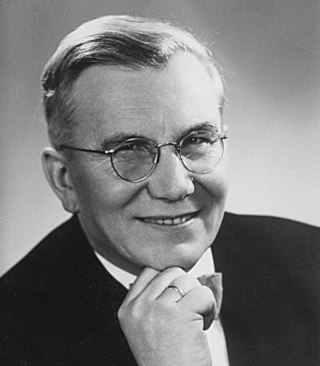
Walter Herrmann was a German nuclear physicist and mechanical engineer who was one of many German nuclear scientists in Soviet program of nuclear weapons, mainly working on the power plant technology at the Laboratory V in Russia.
Ernst Rexer was a German nuclear physicist and a professor of physics at the Dresden University of Technology.
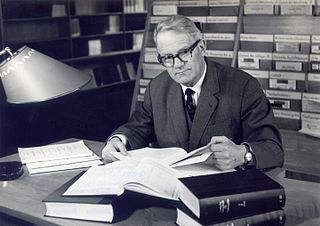
Josef Schintlmeister was an Austrian nuclear physicist and an amateur alpinist.











